Effects of Straw Returning and New Fertilizer Substitution on Rice Growth, Yield, and Soil Properties in the Chaohu Lake Region of China
Abstract
1. Introduction
2. Results
2.1. Rice Growth Parameters
2.2. Rice Yield and Nitrogen and Phosphorus Uptake
2.3. Soil Chemical Properties
2.4. Soil Enzyme Activities
2.5. Correlation Analysis between Rice Growth and Soil Properties
3. Discussion
3.1. Effects of Straw Returning and New Fertilizers Substitution on Rice Growth
3.2. Effects of Straw Returning and New Fertilizers Substitution on Rice Yield and Fertilizer Use Efficiency
3.3. Effects of Straw Returning and New Fertilizers Substitution on Soil Properties
4. Materials and Methods
4.1. Experimental Site
4.2. Materials and Experimental Design
4.3. Soil and Plant Sampling and Analysis
4.3.1. Soil Sampling and Analysis
4.3.2. Plant Sampling and Analysis
4.4. Data Processing and Analysis
4.5. Statistical Analysis
5. Conclusions
Supplementary Materials
Author Contributions
Funding
Data Availability Statement
Acknowledgments
Conflicts of Interest
References
- Li, W.J.; Ruiz-Menjivar, J.; Zhang, L.; Zhang, J.B. Climate change perceptions and the adoption of low-carbon agricultural technologies: Evidence from rice production systems in the Yangtze River Basin. Sci. Total Environ. 2021, 759, 143554. [Google Scholar] [CrossRef]
- Liu, S.L.; Huang, D.Y.; Chen, A.L.; Wei, W.X.; Brookes, P.C.; Li, Y.; Wu, J.S. Differential responses of crop yields and soil organic carbon stock to fertilization and rice straw incorporation in three cropping systems in the subtropics. Agric. Ecosyst. Environ. 2014, 184, 51–58. [Google Scholar] [CrossRef]
- Zhou, P.; Sheng, H.; Li, Y.; Tong, C.L.; Ge, T.D.; Wu, J.S. Lower C sequestration and N use efficiency by straw incorporation than manure amendment on paddy soils. Agric. Ecosyst. Environ. 2016, 219, 93–100. [Google Scholar] [CrossRef]
- Amirahmadi, E.; Moudrý, J.; Konvalina, P.; Hörtenhuber, S.J.; Ghorbani, M.; Neugschwandtner, R.W.; Jiang, Z.; Krexner, T.; Kopecký, M. Environmental Life Cycle Assessment in Organic and Conventional Rice Farming Systems: Using a Cradle to Farm Gate Approach. Sustainability 2022, 14, 15870. [Google Scholar] [CrossRef]
- Ni, B.L.; Liu, M.Z.; Lü, S.Y.; Xie, L.H.; Wang, Y.F. Environmentally Friendly Slow-Release Nitrogen Fertilizer. J. Agric. Food. Chem. 2011, 59, 10169–10175. [Google Scholar] [CrossRef] [PubMed]
- Dong, D.; Li, J.; Ying, S.S.; Wu, J.S.; Han, X.G.; Teng, Y.X.; Zhou, M.R.; Ren, Y.; Jiang, P.K. Mitigation of methane emission in a rice paddy field amended with biochar-based slow-release fertilizer. Sci. Total Environ. 2021, 792, 148460. [Google Scholar] [CrossRef] [PubMed]
- Zhao, Z.; Cao, L.; Sha, Z.; Deng, J.; Chu, C.; Zhou, D.; Wu, S.; Lv, W. Impacts of fertilization optimization on N loss from paddy fields: Observations and DNDC modeling case study in Shanghai, China. Soil Tillage Res. 2020, 199, 104587. [Google Scholar] [CrossRef]
- Liu, L.Y.; Zheng, X.Q.; Peng, C.F.; Li, J.Y.; Xu, Y. Driving forces and future trends on total nitrogen loss of planting in China. Environ. Pollut. 2020, 267, 115660. [Google Scholar] [CrossRef]
- Luo, G.; Sun, M.; Xue, C.; Xu, S.; Chen, K.; Lu, L. Effects of Soil Testing and Formulated Fertilization on the Growth and Yield Formation of Rice. Barley Cereal Sci. 2020, 37, 34–38. [Google Scholar] [CrossRef]
- Wang, R.J.; Wang, Q.B.; Dong, L.S.; Zhang, J.F. Cleaner agricultural production in drinking-water source areas for the control of non-point source pollution in China. J. Environ. Manag. 2021, 285, 112096. [Google Scholar] [CrossRef]
- Niu, X.; Ju, X. Organic fertilizer resources and utilization in China. J. Plant Nutr. Fert. 2017, 23, 1462–1479. [Google Scholar] [CrossRef]
- Wang, H.N.; Yang, G.T.; Wang, X.C.; Zhao, C.K.; Muhammad, N.; Chen, Y.J.; Hu, Y.G. Oilseed rape straw returning changes soil reducibility and affects the root and yield of rice in the rape-rice rotation field at Sichuan Basin area of China. Agron. J. 2020, 112, 4681–4692. [Google Scholar] [CrossRef]
- Liu, X.Q.; Liu, H.R.; Zhang, Y.S.; Chen, G.; Li, Z.H.; Zhang, M.C. Straw return drives soil microbial community assemblage to change metabolic processes for soil quality amendment in a rice-wheat rotation system. Soil Biol. Biochem. 2023, 185, 109131. [Google Scholar] [CrossRef]
- Yin, H.J.; Zhao, W.Q.; Li, T.; Cheng, X.Y.; Liu, Q. Balancing straw returning and chemical fertilizers in China: Role of straw nutrient resources. Renew. Sustain. Energy Rev. 2018, 81, 2695–2702. [Google Scholar] [CrossRef]
- Liu, Y.; Li, J.; Jiao, X.Y.; Li, H.D.; Hu, T.S.; Jiang, H.Z.; Mahmoud, A.L. Effects of biochar on water quality and rice productivity under straw returning condition in a rice-wheat rotation region. Sci. Total Environ. 2022, 819, 152063. [Google Scholar] [CrossRef]
- Naz, M.Y.; Sulaiman, S.A. Slow release coating remedy for nitrogen loss from conventional urea: A review. J. Control. Release 2016, 225, 109–120. [Google Scholar] [CrossRef]
- Li, J.Y.; Liu, Y.; Liu, J.; Cui, X.; Hou, T.D.; Cheng, D.D. A novel synthetic slow release fertilizer with low energy production for efficient nutrient management. Sci. Total Environ. 2022, 831, 154844. [Google Scholar] [CrossRef]
- Liu, J.A.; Shu, A.P.; Song, W.F.; Shi, W.C.; Li, M.C.; Zhang, W.X.; Li, Z.Z.; Liu, G.R.; Yuan, F.S.; Zhang, S.X.; et al. Long-term organic fertilizer substitution increases rice yield by improving soil properties and regulating soil bacteria. Geoderma 2021, 404, 115287. [Google Scholar] [CrossRef]
- Snapp, S.; Sapkota, T.B.; Chamberlin, J.; Cox, C.M.; Gameda, S.; Jat, M.L.; Marenya, P.; Mottaleb, K.A.; Negra, C.; Senthilkumar, K.; et al. Spatially differentiated nitrogen supply is key in a global food-fertilizer price crisis. Nat. Sustain. 2023, 6, 1268–1278. [Google Scholar] [CrossRef]
- Abid, A.A.; Zhang, Q.; Adil, M.F.; Batool, I.; Abbas, M.; Hassan, Z.; Khan, A.A.; Castellano-Hinojosa, A.; Zaidi, S.H.R.; Di, H.; et al. Nitrogen optimization coupled with alternate wetting and drying practice enhances rhizospheric nitrifier and denitrifier abundance and rice productivity. Front. Plant Sci. 2022, 13, 927229. [Google Scholar] [CrossRef] [PubMed]
- Hussain, M.M.; Bibi, I.; Niazi, N.K.; Nawaz, M.F.; Rinklebe, J. Impact of organic and inorganic amendments on arsenic accumulation by rice genotypes under paddy soil conditions: A pilot-scale investigation to assess health risk. J. Hazard. Mater. 2021, 420, 126620. [Google Scholar] [CrossRef]
- Moe, K.; Moh, S.M.; Htwe, A.Z.; Kajihara, Y.; Yamakawa, T. Effects of Integrated Organic and Inorganic Fertilizers on Yield and Growth Parameters of Rice Varieties. Rice Sci. 2019, 26, 309–318. [Google Scholar] [CrossRef]
- Lu, Z.F.; Yu, H.; Xiong, G.S.; Wang, J.; Jiao, Y.Q.; Liu, G.F.; Jing, Y.H.; Meng, X.B.; Hu, X.M.; Qian, Q.; et al. Genome-Wide Binding Analysis of the Transcription Activator Ideal Plant Architecture1 Reveals a Complex Network Regulating Rice Plant Architecture. Plant Cell 2013, 25, 3743–3759. [Google Scholar] [CrossRef] [PubMed]
- Huang, L.Z.; Wang, W.G.; Zhang, N.; Cai, Y.Y.; Liang, Y.; Meng, X.B.; Yuan, Y.D.; Li, J.Y.; Wu, D.X.; Wang, Y.H. LAZY2 controls rice tiller angle through regulating starch biosynthesis in gravity-sensing cells. New Phytol. 2021, 231, 1073–1087. [Google Scholar] [CrossRef] [PubMed]
- Gu, H.-Z.; Wang, X.; Zhang, M.-H.; Jing, W.-J.; Wu, H.; Xiao, Z.-L.; Zhang, W.-Y.; Gu, J.-F.; Liu, L.-J.; Wang, Z.-Q.; et al. The response of roots and rhizosphere environment to integrative cultivation practices in paddy rice. J. Integr. Agric. 2023, in press. [Google Scholar] [CrossRef]
- Wang, X.; Zhang, Z.F.; Peng, W.; Huang, J.Q.; Yan, X.; Yao, W.; Ouyang, J.X.; Li, S.B. Inositolphosphorylceramide synthases, OsIPCSs, regulate plant height in rice. Plant Sci. 2023, 335, 111798. [Google Scholar] [CrossRef] [PubMed]
- Ji, Y.Y.; Huang, W.T.; Wu, B.W.; Fang, Z.M.; Wang, X.L. The amino acid transporter AAP1 mediates growth and grain yield by regulating neutral amino acid uptake and reallocation in Oryza sativa. J. Exp. Bot. 2020, 71, 4763–4777. [Google Scholar] [CrossRef] [PubMed]
- Wang, H.; Wang, X.; Huang, J.; Li, J.; Hu, Y. Effect of straw incorporated into soil on reducibility in soil and root system and yield of rice. Trans. Chin. Soc. Agric. Eng. 2017, 33, 116–126. [Google Scholar] [CrossRef]
- Saha, R.; Mishra, V.K. Effect of Organic Residue Management on Soil Hydro-Physical Characteristics and Rice Yield in Eastern Himalayan Region, India. J. Sustain. Agric. 2009, 33, 161–176. [Google Scholar] [CrossRef]
- Tian, J.Y.; Li, S.P.; Xing, Z.P.; Cheng, S.; Guo, B.W.; Hu, Y.J.; Wei, H.Y.; Gao, H.; Liao, P.; Wei, H.H.; et al. Differences in rice yield and biomass accumulation dynamics for different direct seeding methods after wheat straw return. Food Energy Secur. 2022, 11, e425. [Google Scholar] [CrossRef]
- Wang, X.C.; Samo, N.; Zhao, C.K.; Wang, H.N.; Yang, G.T.; Hu, Y.G.; Peng, Y.L.; Rasul, F. Negative and Positive Impacts of Rape Straw Returning on the Roots Growth of Hybrid Rice in the Sichuan Basin Area. Agronomy 2019, 9, 690. [Google Scholar] [CrossRef]
- Li, H.D.; Liu, Y.; Jiao, X.Y.; Li, J.; Liu, K.H.; Wu, T.A.; Zhang, Z.Z.; Luo, D.H. Response of soil nutrients retention and rice growth to biochar in straw returning paddy fields. Chemosphere 2023, 312, 137244. [Google Scholar] [CrossRef] [PubMed]
- Gao, J.; Zhao, B.; Dong, S.T.; Liu, P.; Ren, B.Z.; Zhang, J.W. Response of Summer Maize Photosynthate Accumulation and Distribution to Shading Stress Assessed by Using 13CO2 Stable Isotope Tracer in the Field. Front. Plant Sci. 2017, 8, 1821. [Google Scholar] [CrossRef] [PubMed]
- Shivay, Y.S.; Prasad, R.; Pal, M. Effect of nitrogen levels and coated urea on growth, yields and nitrogen use efficiency in aromatic rice. J. Plant Nutr. 2016, 39, 875–882. [Google Scholar] [CrossRef]
- Evans, J.R.; Clarke, V.C. The nitrogen cost of photosynthesis. J. Exp. Bot. 2019, 70, 7–15. [Google Scholar] [CrossRef] [PubMed]
- Altaf, K.; Younis, A.; Ramzan, Y.; Ramzan, F. Effect of composition of agricultural wastes and biochar as a growing media on the growth of potted Stock (Matthiola incana) and Geranium (Pelargonium spp). J. Plant Nutr. 2021, 44, 919–930. [Google Scholar] [CrossRef]
- Popko, M.; Michalak, I.; Wilk, R.; Gramza, M.; Chojnacka, K.; Górecki, H. Effect of the New Plant Growth Biostimulants Based on Amino Acids on Yield and Grain Quality of Winter Wheat. Molecules 2018, 23, 470. [Google Scholar] [CrossRef]
- Subbarao, S.B.; Hussain, I.S.A.; Ganesh, P.T. Bio Stimulant Activity of Protein Hydrolysate: Influence on Plant Growth and Yield. J. Plant Sci. Res. 2015, 2, 125. [Google Scholar]
- Guo, N.; Hu, J.Q.; Yan, M.; Qu, H.Y.; Luo, L.; Tegeder, M.; Xu, G.H. Oryza sativa Lysine-Histidine-type Transporter 1 functions in root uptake and root-to-shoot allocation of amino acids in rice. Plant J. 2020, 103, 395–411. [Google Scholar] [CrossRef]
- Ye, Y.S.; Liang, X.Q.; Chen, Y.X.; Liu, J.; Gu, J.T.; Guo, R.; Li, L. Alternate wetting and drying irrigation and controlled-release nitrogen fertilizer in late-season rice. Effects on dry matter accumulation, yield, water and nitrogen use. Field Crops Res. 2013, 144, 212–224. [Google Scholar] [CrossRef]
- Yang, Y.; Liu, B.M.; Ni, X.Y.; Tao, L.Z.; Yu, L.X.; Yang, Y.; Feng, M.X.; Zhong, W.J.; Wu, Y.J. Rice productivity and profitability with slow-release urea containing organic-inorganic matrix materials. Pedosphere 2021, 31, 511–520. [Google Scholar] [CrossRef]
- Zhu, L.X.; Zhang, W.J. Effects of controlled-release urea combined with conventional urea on nitrogen uptake, root yield, and quality of Platycodon grandiflorum. J. Plant Nutr. 2017, 40, 662–672. [Google Scholar] [CrossRef]
- Wang, L.; Xue, C.; Pan, X.; Chen, F.; Liu, Y. Application of Controlled-Release Urea Enhances Grain Yield and Nitrogen Use Efficiency in Irrigated Rice in the Yangtze River Basin, China. Front. Plant Sci. 2018, 9, 999. [Google Scholar] [CrossRef] [PubMed]
- Lyu, Y.F.; Yang, X.D.; Pan, H.Y.; Zhang, X.H.; Cao, H.X.; Ulgiati, S.; Wu, J.; Zhang, Y.Z.; Wang, G.Y.; Xiao, Y.L. Impact of fertilization schemes with different ratios of urea to controlled release nitrogen fertilizer on environmental sustainability, nitrogen use efficiency and economic benefit of rice production: A study case from Southwest China. J. Clean. Prod. 2021, 293, 126198. [Google Scholar] [CrossRef]
- Wang, H.; Li, Y.; Sun, Y.; Li, Y.; Jiang, M.; Wang, C.; Zhao, J.; Sun, Y.; Xu, H.; Yan, F.; et al. Effects of slow-release urea on nitrogen utilization and yield in mechanically-transplanted rice under different nitrogen application rates. Chin. J. Rice Sci. 2017, 31, 50–64. [Google Scholar] [CrossRef]
- Polthanee, A.; Tre-loges, V.; Promsena, K. Effect of rice straw management and organic fertilizer application on growth and yield of dry direct-seeded rice. Paddy Water Environ. 2008, 6, 237–241. [Google Scholar] [CrossRef]
- Zhao, F.C.; Li, F.; Zhou, J.; Sun, X.L.; Wang, Y.; Jing, L.Q.; Hou, J.F.; Bao, F.; Wang, G.Y.; Chen, B. Soiltesting formula fertilization with organic fertilizer addition for target yield cannot stand long due to stem lodging of rice. Front. Plant Sci. 2022, 13, 1091156. [Google Scholar] [CrossRef] [PubMed]
- Pleijel, H.; Broberg, M.C.; Högy, P.; Uddling, J. Nitrogen application is required to realize wheat yield stimulation by elevated CO2 but will not remove the CO2-induced reduction in grain protein concentration. Glob. Chang. Biol. 2019, 25, 1868–1876. [Google Scholar] [CrossRef]
- Sun, H.F.; Zhou, S.; Zhang, J.N.; Zhang, X.X.; Wang, C. Effects of controlled-release fertilizer on rice grain yield, nitrogen use efficiency, and greenhouse gas emissions in a paddy field with straw incorporation. Field Crops Res. 2020, 253, 107814. [Google Scholar] [CrossRef]
- Cao, Y.S.; Sun, H.F.; Zhang, J.N.; Chen, G.F.; Zhu, H.T.; Zhou, S.; Xiao, H.Y. Effects of wheat straw addition on dynamics and fate of nitrogen applied to paddy soils. Soil Tillage Res. 2018, 178, 92–98. [Google Scholar] [CrossRef]
- Sullivan, W.M.; Jiang, Z.C.; Hull, R.J. Root morphology and its relationship with nitrate uptake in Kentucky bluegrass. Crop Sci. 2000, 40, 765–772. [Google Scholar] [CrossRef]
- Mantelin, S.; Touraine, B. Plant growth-promoting bacteria and nitrate availability: Impacts on root development and nitrate uptake. J. Exp. Bot. 2004, 55, 27–34. [Google Scholar] [CrossRef] [PubMed]
- Farrell, M.; Prendergast-Miller, M.; Jones, D.L.; Hill, P.W.; Condron, L.M. Soil microbial organic nitrogen uptake is regulated by carbon availability. Soil Biol. Biochem. 2014, 77, 261–267. [Google Scholar] [CrossRef]
- Kirk, G.J.D. Plant-mediated processess to acquire nutrients: Nitrogen uptake by rice plants. Plant Soil 2001, 232, 129–134. [Google Scholar] [CrossRef]
- Fu, J.; Zhu, Y.; Jiang, L. Use of Controlled Release Fertilizer for Increasing N Efficiency of Direct Seeding Rice. Pedosphere 2001, 11, 333–339. [Google Scholar]
- Zhu, Z.; Zhang, F.G.; Wang, C.; Ran, W.; Shen, Q.R. Treating fermentative residues as liquid fertilizer and its efficacy on the tomato growth. Sci. Hortic. 2013, 164, 492–498. [Google Scholar] [CrossRef]
- Oladele, S.O. Changes in physicochemical properties and quality index of an Alfisol after three years of rice husk biochar amendment in rainfed rice—Maize cropping sequence. Geoderma 2019, 353, 359–371. [Google Scholar] [CrossRef]
- Li, X.L.; Wang, Y.Q.; Zhang, Y.; Wang, Y.J.; Pei, C.M. Response of soil chemical properties and enzyme activity of four species in the Three Gorges Reservoir area to simulated acid rain. Ecotoxicol. Environ. Saf. 2021, 208, 111457. [Google Scholar] [CrossRef]
- González-Cencerrado, A.; Ranz, J.P.; Jiménez, M.; Gajardo, B.R. Assessing the environmental benefit of a new fertilizer based on activated biochar applied to cereal crops. Sci. Total Environ. 2020, 711, 134668. [Google Scholar] [CrossRef]
- Ghafoor, I.; Habib-ur-Rahman, M.; Ali, M.; Afzal, M.; Ahmed, W.; Gaiser, T.; Ghaffar, A. Slow-release nitrogen fertilizers enhance growth, yield, NUE in wheat crop and reduce nitrogen losses under an arid environment. Environ. Sci. Pollut. Res. 2021, 28, 43528–43543. [Google Scholar] [CrossRef]
- Yu, Z.X.; Shen, Z.Y.; Xu, L.; Yu, J.; Zhang, L.; Wang, X.K.; Yin, G.D.; Zhang, W.J.; Li, Y.L.; Zuo, W.G.; et al. Effect of Combined Application of Slow-Release and Conventional Urea on Yield and Nitrogen Use Efficiency of Rice and Wheat under Full Straw Return. Agronomy 2022, 12, 998. [Google Scholar] [CrossRef]
- Guan, G.A.; Tu, S.X.; Yang, J.C.; Zhang, J.F.; Yang, L. The effects of slow-release nitrogen fertilization models on soil biological properties in rice-wheat cropping system. J. Food Agric. Env. 2010, 8, 741–746. [Google Scholar]
- Nishino, S.F.; Spain, J.C. Biodegradation of 3-Nitrotyrosine by Burkholderia sp. Strain JS165 and Variovorax paradoxus JS171. Appl. Environ. Microbiol. 2006, 72, 1040–1044. [Google Scholar] [CrossRef] [PubMed]
- Zhang, S.J.; Zhang, G.; Wang, D.J.; Liu, Q. Long-term straw return with N addition alters reactive nitrogen runoff loss and the bacterial community during rice growth stages. J. Environ. Manag. 2021, 292, 112772. [Google Scholar] [CrossRef] [PubMed]
- Wang, H.X.; Xu, J.L.; Liu, X.J.; Zhang, D.; Li, L.W.; Li, W.; Sheng, L.X. Effects of long-term application of organic fertilizer on improving organic matter content and retarding acidity in red soil from China. Soil Tillage Res. 2019, 195, 104382. [Google Scholar] [CrossRef]
- Zhao, K.; Cai, Z.; Wang, B.; Wen, S.; Zhou, X.; Sun, N. Changes in pH and Exchangeable Acidity at Depths of Red Soils Derived from 4 Parent Materials Under 3 Vegetations. Sci. Agric. Sin. 2015, 48, 4818–4826. [Google Scholar] [CrossRef]
- Liao, B.; Liao, P.; Hu, R.; Cai, T.; Zhang, Y.; Yu, Q.; Zhang, B.; Shu, Y.; Wang, J.; Luo, Y.; et al. Mitigating ammonia volatilization in rice cultivation: The impact of partial organic fertilizer substitution. Chemosphere 2023, 344, 140326. [Google Scholar] [CrossRef] [PubMed]
- Nobile, C.M.; Bravin, M.N.; Becquer, T.; Paillat, J.M. Phosphorus sorption and availability in an andosol after a decade of organic or mineral fertilizer applications: Importance of pH and organic carbon modifications in soil as compared to phosphorus accumulation. Chemosphere 2020, 239, 124709. [Google Scholar] [CrossRef]
- Wang, L.F.; Du, H.C.; Han, Z.Q.; Zhang, X.L. Nitrous oxide emissions from black soils with different pH. J. Environ. Sci. 2013, 25, 1071–1076. [Google Scholar] [CrossRef]
- Mi, W.H.; Wu, L.H.; Brookes, P.C.; Liu, Y.L.; Zhang, X.; Yang, X. Changes in soil organic carbon fractions under integrated management systems in a low-productivity paddy soil given different organic amendments and chemical fertilizers. Soil Tillage Res. 2016, 163, 64–70. [Google Scholar] [CrossRef]
- Mi, W.H.; Sun, Y.; Xia, S.Q.; Zhao, H.T.; Mi, W.T.; Brookes, P.C.; Liu, Y.L.; Wu, L.H. Effect of inorganic fertilizers with organic amendments on soil chemical properties and rice yield in a low-productivity paddy soil. Geoderma 2018, 320, 23–29. [Google Scholar] [CrossRef]
- Fang, Q.X.; Yu, Q.; Wang, E.L.; Chen, Y.H.; Zhang, G.L.; Wang, J.; Li, L.H. Soil nitrate accumulation, leaching and crop nitrogen use as influenced by fertilization and irrigation in an intensive wheat-maize double cropping system in the North China Plain. Plant Soil 2006, 284, 335–350. [Google Scholar] [CrossRef]
- Owens, L.B.; Edwards, W.M.; Van Keuren, R.W. Groundwater Nitrate Levels under Fertilized Grass and Grass-Legume Pastures. J. Environ. Qual. 1994, 23, 752–758. [Google Scholar] [CrossRef]
- Gao, S.; DeLuca, T.H.; Cleveland, C.C. Biochar additions alter phosphorus and nitrogen availability in agricultural ecosystems: A meta-analysis. Sci. Total Environ. 2019, 654, 463–472. [Google Scholar] [CrossRef] [PubMed]
- Yan, X.; Wang, D.J.; Zhang, H.L.; Zhang, G.; Wei, Z.Q. Organic amendments affect phosphorus sorption characteristics in a paddy soil. Agric. Ecosyst. Environ. 2013, 175, 47–53. [Google Scholar] [CrossRef]
- Gao, P.; Zhang, T.; Lei, X.Y.; Cui, X.W.; Lu, Y.X.; Fan, P.F.; Long, S.P.; Huang, J.; Gao, J.S.; Zhang, Z.H.; et al. Improvement of soil fertility and rice yield after long-term application of cow manure combined with inorganic fertilizers. J. Integr. Agric. 2023, 22, 2221–2232. [Google Scholar] [CrossRef]
- Burns, R.G.; DeForest, J.L.; Marxsen, J.; Sinsabaugh, R.L.; Stromberger, M.E.; Wallenstein, M.D.; Weintraub, M.N.; Zoppini, A. Soil enzymes in a changing environment: Current knowledge and future directions. Soil Biol. Biochem. 2013, 58, 216–234. [Google Scholar] [CrossRef]
- Yu, P.J.; Liu, S.W.; Han, K.X.; Guan, S.C.; Zhou, D.W. Conversion of cropland to forage land and grassland increases soil labile carbon and enzyme activities in northeastern China. Agric. Ecosyst. Environ. 2017, 245, 83–91. [Google Scholar] [CrossRef]
- Murray, A.H.; Iason, G.R.; Stewart, C. Effect of simple phenolic compounds of heather (Calluna vulgaris) on rumen microbial activity in vitro. J. Chem. Ecol. 1996, 22, 1493–1504. [Google Scholar] [CrossRef]
- Reza, R.; Ganguly, P.; Dutta, S.K.; Das, A.; Shambhavi, S.; Rakshit, R. Biochemical Response of Plant and Soil to Varied Levels of Nitrogen and Penoxsulam Application in Rice Crop. J. Soil Sci. Plant Nutr. 2023, 23, 4373–4384. [Google Scholar] [CrossRef]
- Nath, C.P.; Kumar, N.; Dutta, A.; Hazra, K.K.; Praharaj, C.S.; Singh, S.S.; Das, K. Pulse crop and organic amendments in cropping system improve soil quality in rice ecology: Evidence from a long-term experiment of 16 years. Geoderma 2023, 430, 116334. [Google Scholar] [CrossRef]
- Bao, S.D. Soil Agrochemical Analysis; China Agriculture Press: Beijing, China, 2000; pp. 30-34, 42–58, 71–80, 103–106, 264–271. [Google Scholar]
- Jiang, Y.; Yi, X.T.; Liu, M.Y.; Liu, B.B.; Zhou, H.; Zeng, P.; Liao, B.H.; Gu, J.F. Dynamic responses of soil enzymes at key growth stages in rice after the in situ remediation of paddy soil contaminated with cadmium and arsenic. Sci. Total Environ. 2022, 830, 154633. [Google Scholar] [CrossRef] [PubMed]
- Wu, Q.; Wang, Y.H.; Ding, Y.F.; Tao, W.K.; Gao, S.; Li, Q.X.; Li, W.W.; Liu, Z.H.; Li, G.H. Effects of different types of slow- and controlled-release fertilizers on rice yield. J. Integr. Agric. 2021, 20, 1503–1514. [Google Scholar] [CrossRef]
- Rahimizadeh, M.; Kashani, A.; Zare-Feizabadi, A.; Koocheki, A.R.; Nassiri-Mahallati, M. Nitrogen use efficiency of wheat as affected by preceding crop, application rate of nitrogen and crop residues. Aust. J. Crop Sci. 2010, 4, 363–368. [Google Scholar]
- Bandaogo, A.; Bidjokazo, F.; Youl, S.; Safo, E.; Abaidoo, R.; Andrews, O. Effect of fertilizer deep placement with urea supergranule on nitrogen use efficiency of irrigated rice in Sourou Valley (Burkina Faso). Nutr. Cycl. Agroecosyst. 2014, 102, 79–89. [Google Scholar] [CrossRef]
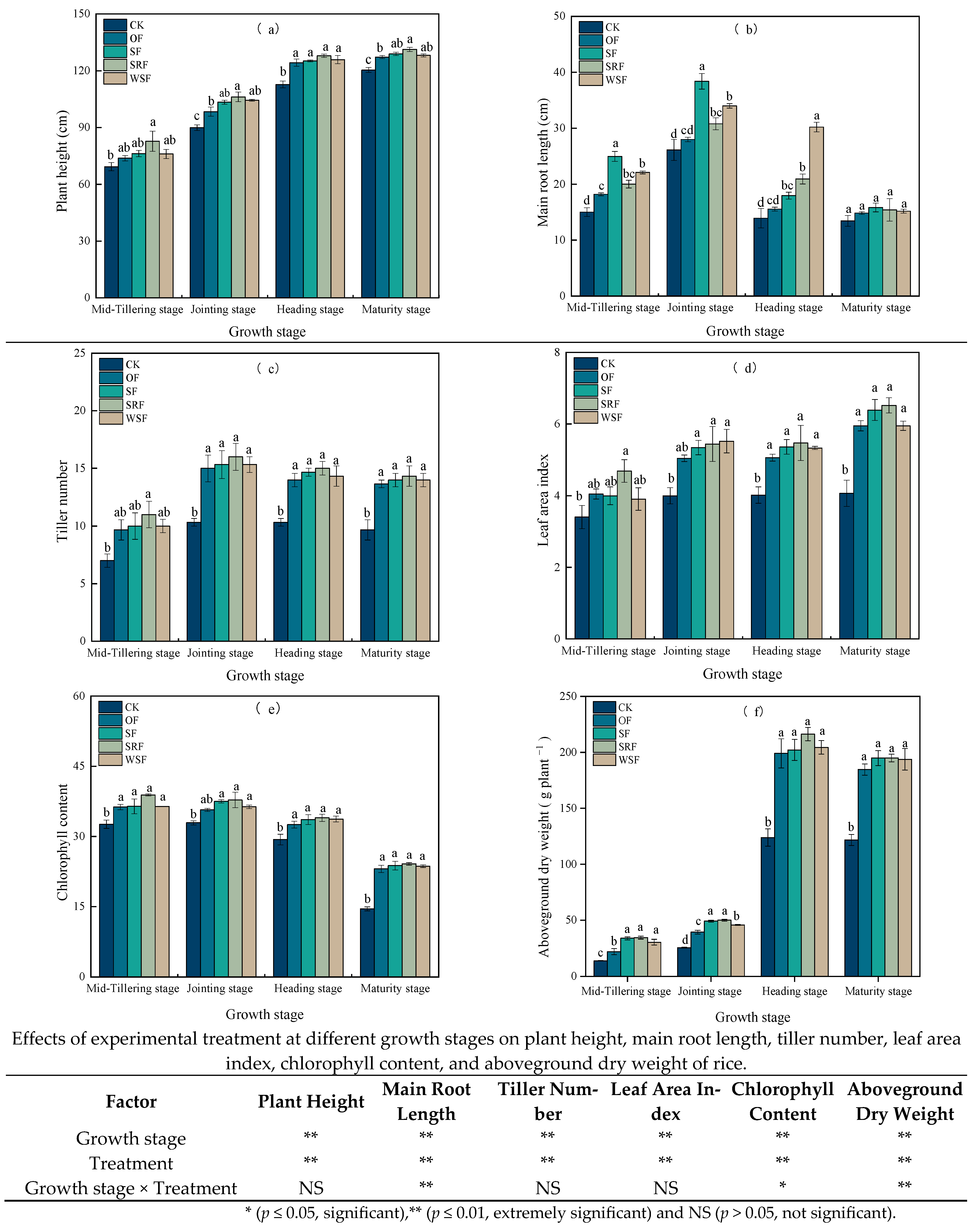
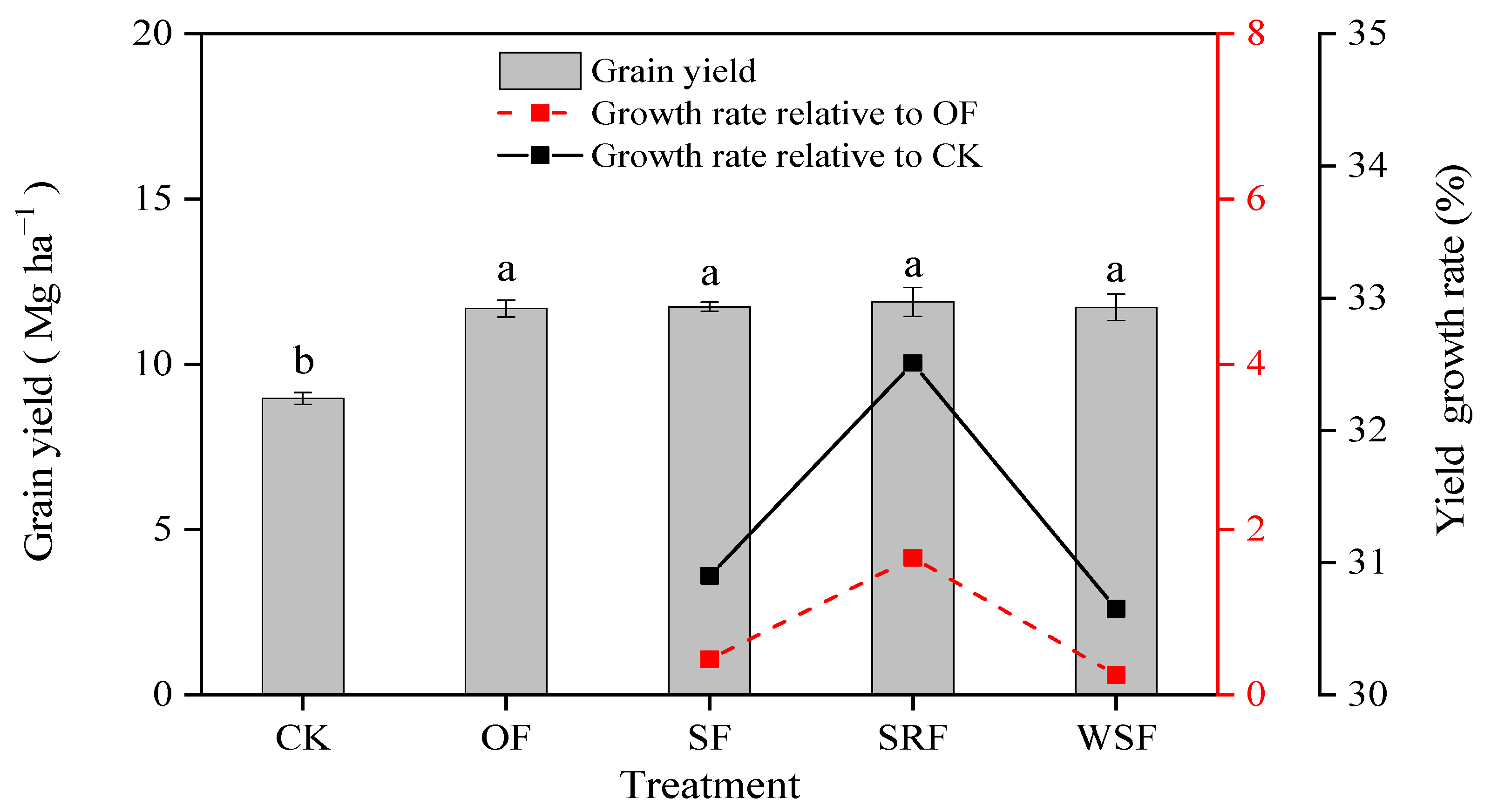

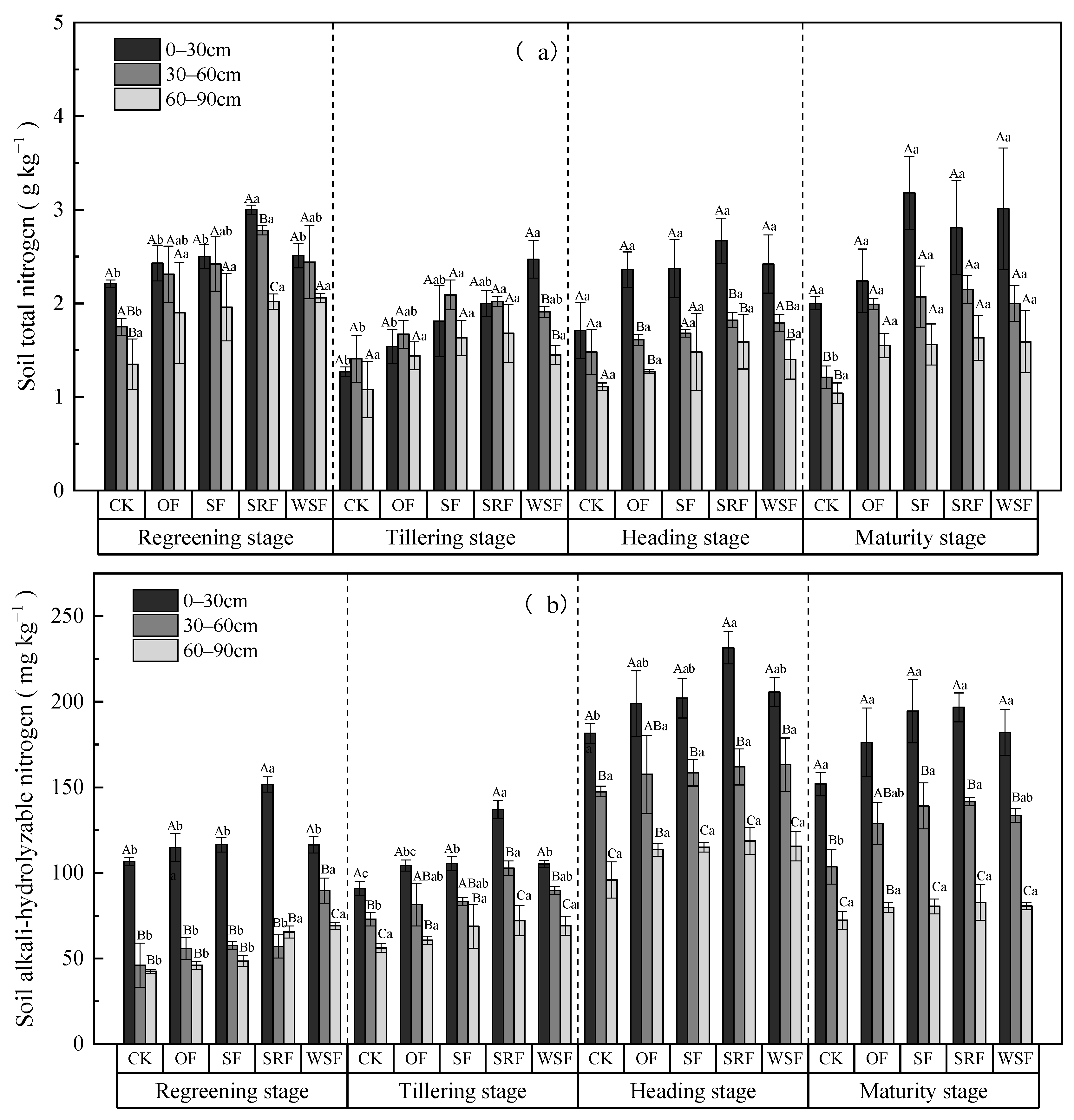

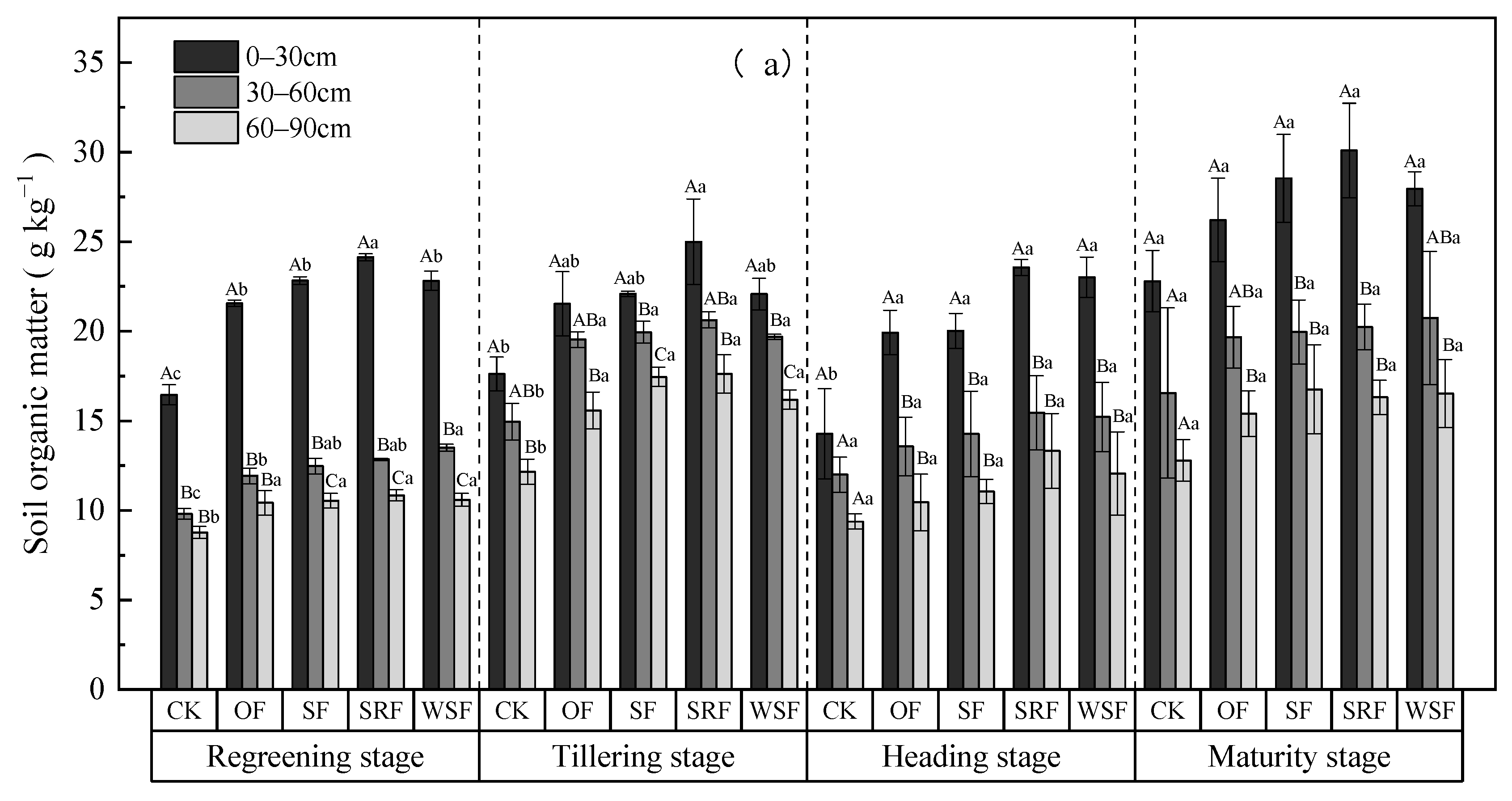


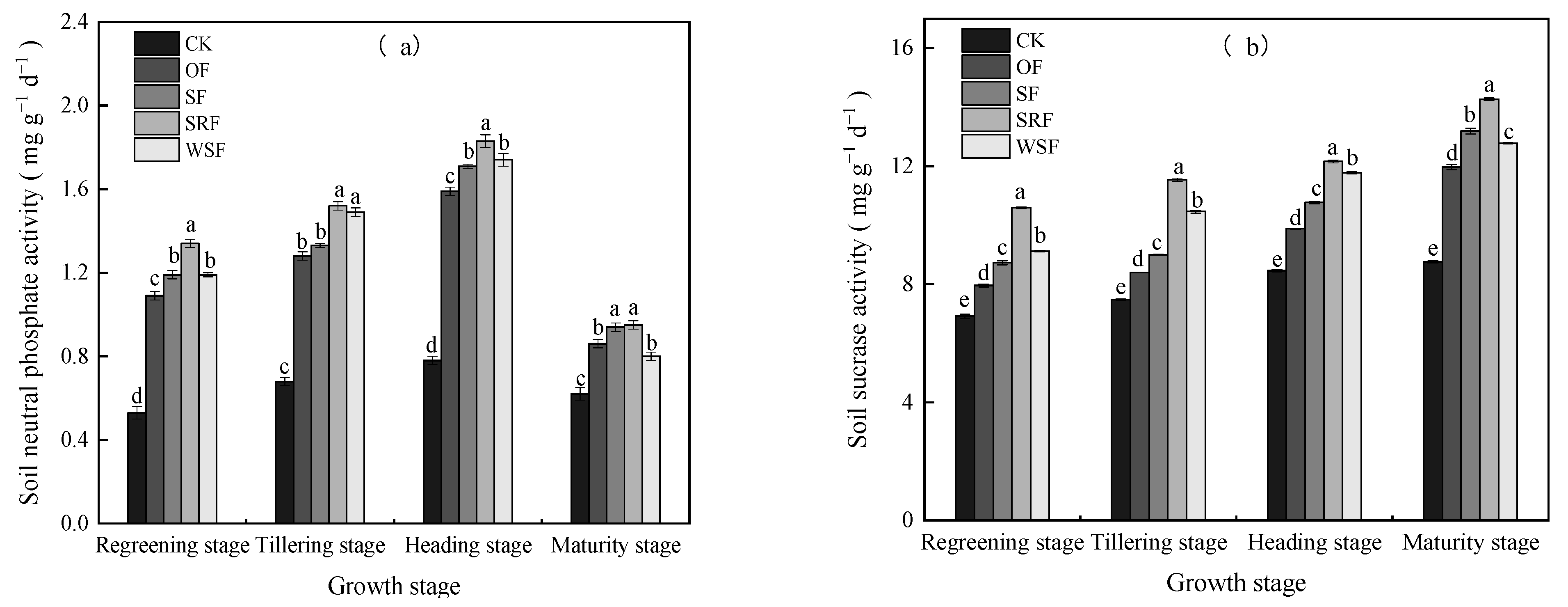
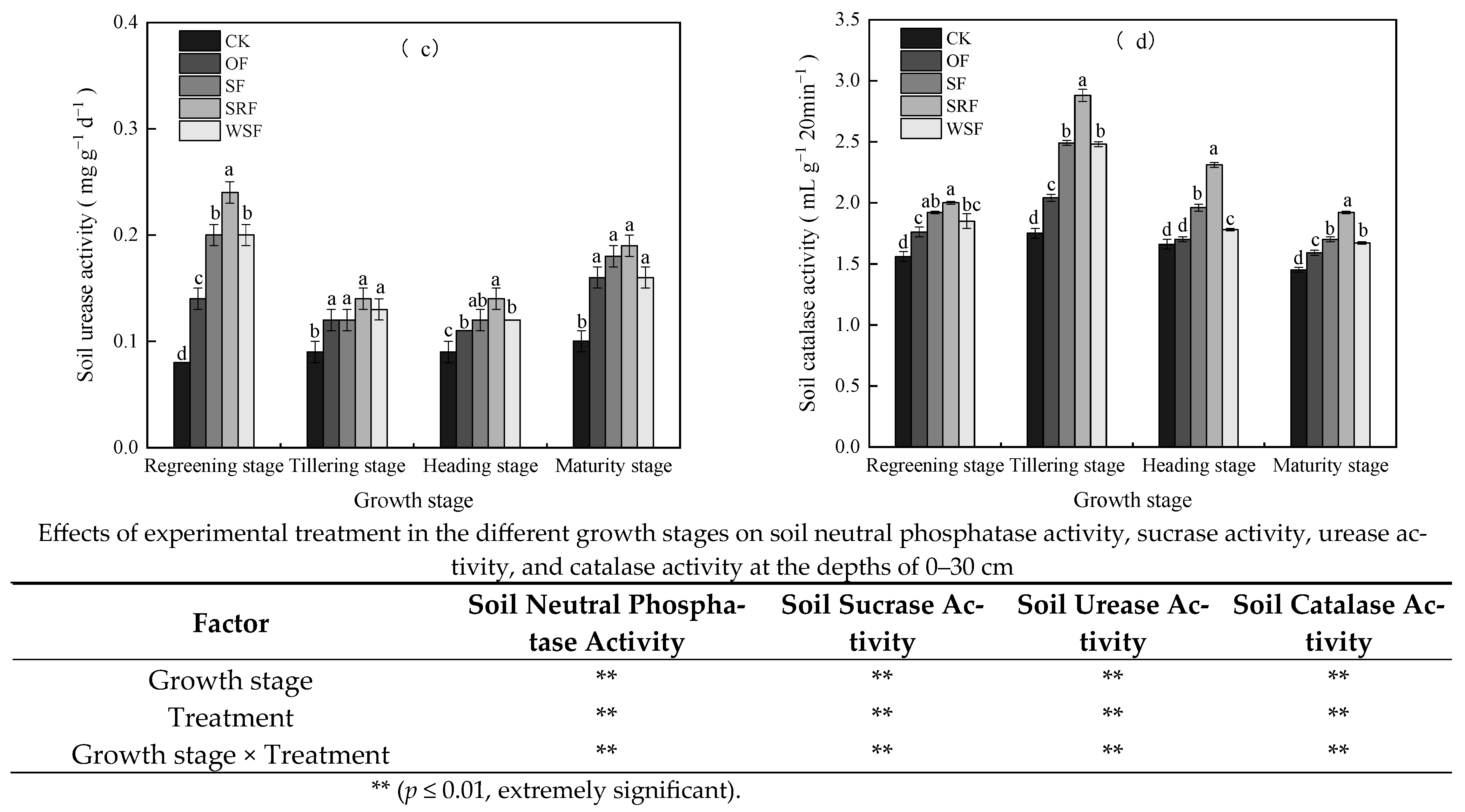
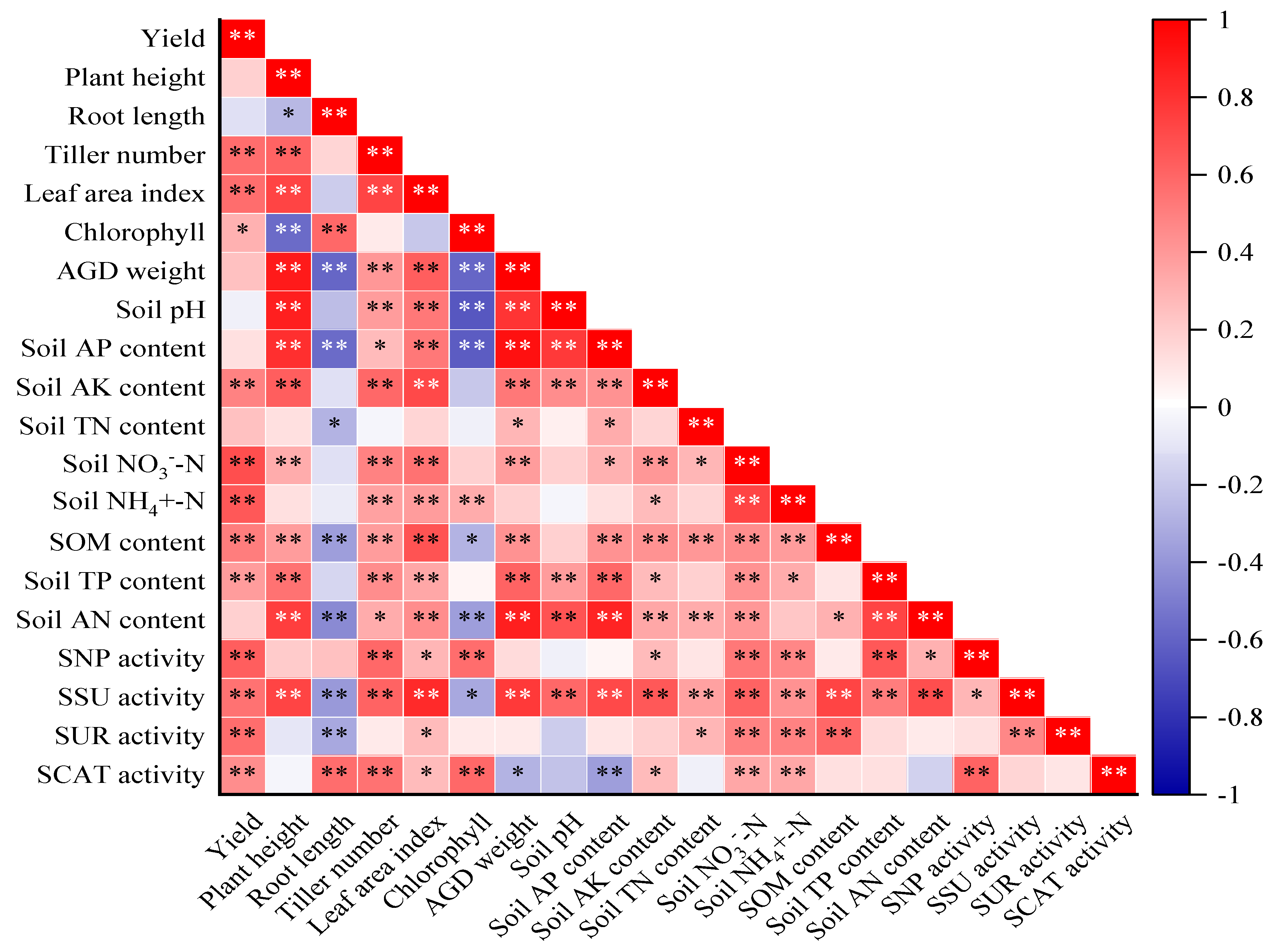
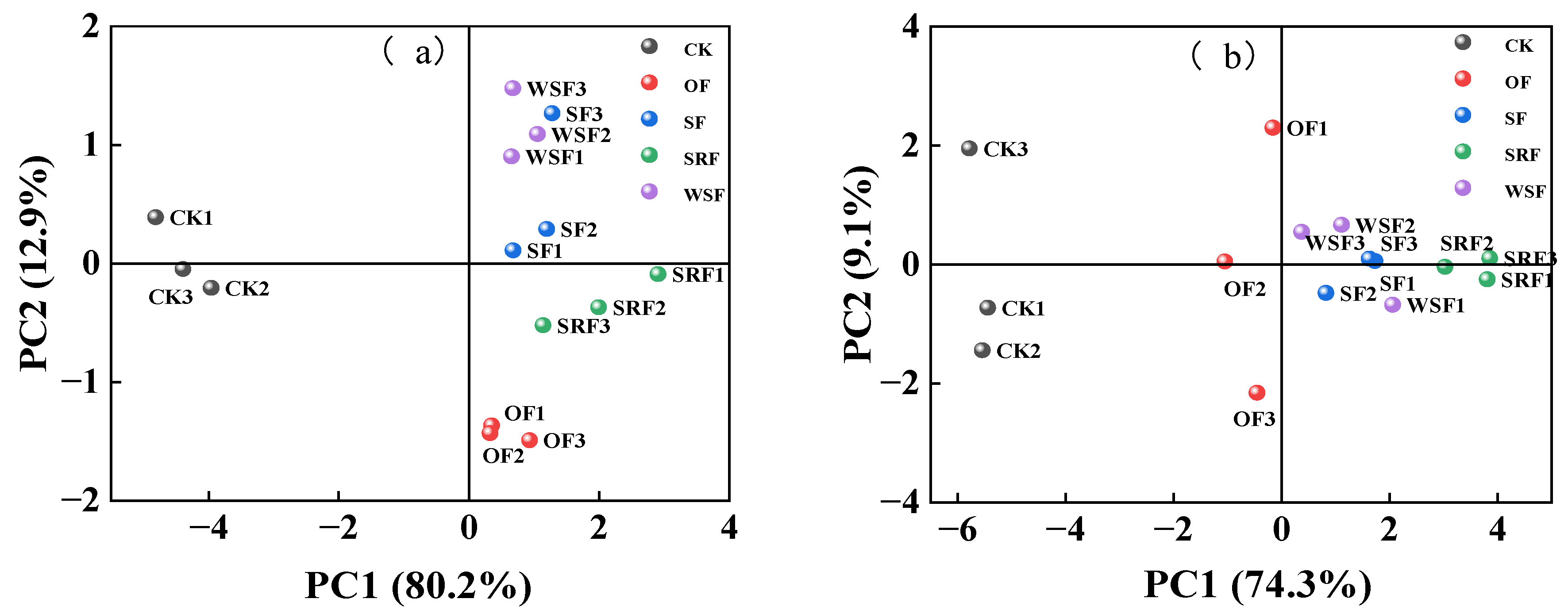

| Experimental Treatment | Grain N Uptake (kg ha−1) | Straw N Uptake (kg ha−1) | N Harvest Index | Partial N Productivity (kg kg−1) | Grain P Uptake (kg ha−1) | Straw P Uptake (kg ha−1) | P Harvest Index | Partial P Productivity (kg kg−1) |
|---|---|---|---|---|---|---|---|---|
| CK | 58.78 ± 3.07 c | 57.39 ± 2.18 b | 0.50 ± 0.01 b | / | 18.36 ± 0.71 c | 21.30 ± 0.99 c | 0.463 ± 0.01 b | / |
| OF | 144.77 ± 5.37 b | 108.35 ± 2.89 a | 0.57 ± 0.01 a | 62.78 ± 1.58 a | 34.91 ± 1.20 b | 33.86 ± 1.47 b | 0.507 ± 0.00 a | 200.58 ± 5.07 a |
| SF | 153.87 ± 2.10 ab | 114.64 ± 4.01 a | 0.56 ± 0.01 a | 63.23 ± 1.38 a | 35.60 ± 0.85 b | 33.95 ± 0.64 b | 0.513 ± 0.00 a | 202.02 ± 4.41 a |
| SRF | 173.93 ± 9.86 a | 126.73 ± 5.53 a | 0.58 ± 0.01 a | 64.44 ± 2.41 a | 45.14 ± 2.23 a | 43.35 ± 1.37 a | 0.510 ± 0.01 a | 205.87 ± 7.69 a |
| WSF | 149.42 ± 5.53 b | 110.59 ± 9.57 a | 0.58 ± 0.01 a | 63.53 ± 2.97 a | 42.78 ± 1.78 a | 41.27 ± 2.30 a | 0.510 ± 0.01 a | 202.98 ± 9.48 a |
| Soil Depth (cm) | BD (g cm−3) | pH | TN (g kg−1) | TP (g kg−1) | AK (mg kg−1) | AP (mg kg−1) | AN (mg kg−1) | SOM (g kg−1) |
|---|---|---|---|---|---|---|---|---|
| 0–30 | 1.25 | 7.08 | 2.09 | 0.17 | 130 | 14.96 | 91.00 | 19.54 |
| 30–60 | 1.40 | 6.87 | 1.11 | 0.16 | 110 | 5.83 | 25.48 | 9.56 |
| 60–90 | 1.47 | 6.91 | 1.23 | 0.17 | 100 | 3.82 | 21.84 | 6.94 |
Disclaimer/Publisher’s Note: The statements, opinions and data contained in all publications are solely those of the individual author(s) and contributor(s) and not of MDPI and/or the editor(s). MDPI and/or the editor(s) disclaim responsibility for any injury to people or property resulting from any ideas, methods, instructions or products referred to in the content. |
© 2024 by the authors. Licensee MDPI, Basel, Switzerland. This article is an open access article distributed under the terms and conditions of the Creative Commons Attribution (CC BY) license (https://creativecommons.org/licenses/by/4.0/).
Share and Cite
Luo, M.; Liu, Y.; Li, J.; Gao, T.; Wu, S.; Wu, L.; Lai, X.; Xu, H.; Hu, H.; Ma, Y. Effects of Straw Returning and New Fertilizer Substitution on Rice Growth, Yield, and Soil Properties in the Chaohu Lake Region of China. Plants 2024, 13, 444. https://doi.org/10.3390/plants13030444
Luo M, Liu Y, Li J, Gao T, Wu S, Wu L, Lai X, Xu H, Hu H, Ma Y. Effects of Straw Returning and New Fertilizer Substitution on Rice Growth, Yield, and Soil Properties in the Chaohu Lake Region of China. Plants. 2024; 13(3):444. https://doi.org/10.3390/plants13030444
Chicago/Turabian StyleLuo, Mei, Ying Liu, Jing Li, Tingfeng Gao, Sheng Wu, Lei Wu, Xijun Lai, Hongjun Xu, Hongxiang Hu, and Youhua Ma. 2024. "Effects of Straw Returning and New Fertilizer Substitution on Rice Growth, Yield, and Soil Properties in the Chaohu Lake Region of China" Plants 13, no. 3: 444. https://doi.org/10.3390/plants13030444
APA StyleLuo, M., Liu, Y., Li, J., Gao, T., Wu, S., Wu, L., Lai, X., Xu, H., Hu, H., & Ma, Y. (2024). Effects of Straw Returning and New Fertilizer Substitution on Rice Growth, Yield, and Soil Properties in the Chaohu Lake Region of China. Plants, 13(3), 444. https://doi.org/10.3390/plants13030444






